Insert Sort & Merge Sort Using C Programming
- 2. 2 Insertion Sort • Suppose we know how to insert a new element x in its proper place in an already sorted array A of size k, to get a new sorted array of size k+1 • Use this to sort the given array A of size n as follows: – Insert A[1] in the sorted array A[0]. So now A[0],A[1] are sorted – Insert A[2] in the sorted array A[0],A[1]. So now A[0],A[1],A[2] are sorted – Insert A[3] in the sorted array A[0],A[1],A[2]. So now A[0],A[1],A[2],A[3] are sorted – ….. – Insert A[i] in the sorted array A[0],A[1],…,A[i-1]. So now A[0],A[1],…A[i] are sorted – Continue until i = n-1 (outer loop)
- 3. 3 How to do the first step • Compare x with A[k-1] (the last element) – If x ≥ A[k-1], we can make A[k] = x (as x is the max of all the elements) – If x < A[k-1], put A[k] = A[k-1] to create a hole in the k- th position, put x there • Now repeat by comparing x with A[k-2] (inserting x in its proper place in the sorted subarray A[0],A[1],…A[k-1] of k-2 elements) • The value x bubbles to the left until it finds an element A[i] such that x ≥ A[i] • No need to compare any more as all elements A[0], A[1], A[i] are less than x
- 4. 4 Example of first step 5 7 11 13 20 22 A Insert x = 15
- 5. 5 Example of first step 5 7 11 13 20 22 5 7 11 13 20 15 22 A Insert x = 15 Compare with 22. x < 22, so move 22 right
- 6. 6 Example of first step 5 7 11 13 20 22 5 7 11 13 20 15 22 5 7 11 13 15 20 22 A Insert x = 15 Compare with 22. x < 22, so move 22 right Compare with 20. x < 20, so move 20 right
- 7. 7 Example of first step 5 7 11 13 20 22 5 7 11 13 20 15 22 5 7 11 13 15 20 22 5 7 11 13 15 20 22 A Insert x = 15 Compare with 22. x < 22, so move 22 right Compare with 20. x < 20, so move 20 right Compare with 13. x > 13, so stop A
- 8. 8 Sort using the insertion 7 5 13 11 22 20 5 7 13 11 22 20 5 7 13 11 22 20 5 7 11 13 22 20 A Insert 5 in 7 Insert 13 in 5, 7 Insert 11 in 5, 7, 13 Insert 22 in 5, 7, 11, 13 Insert 20 in 5, 7, 11, 13, 22 5 7 11 13 20 22 5 7 11 13 22 20
- 9. 9 Insertion Sort Code void InsertionSort (int A[ ], int size) { int i, j, item; for (i=1; i<size; i++) { /* Insert the element in A[i] */ item = A[i] ; for (j = i-1; j >= 0; j--) if (item < A[j]) { /* push elements down*/ A[j+1] = A[j]; A[j] = item ; /* can do this on } else break; /*inserted, exit loop */ } }
- 10. 10 Look at the so 8 2 9 4 7 6 2 1 5 i = 1:: 2, 9, 4, 7 i = 2:: 9, 2, 4, 7 i = 3:: 9, 4, 2, 7 i = 4:: 9, 7, 4, 2 i = 5:: 9, 7, 6, 4 i = 6:: 9, 7, 6, 4 i = 7:: 9, 7, 6, 4 Result = 9, 7, 6, 5 void InsertionSort (int A[ ], int size) { int i,j, item; for (i=1; i<size; i++) { printf("i = %d:: ",i); for (j=0;j<size;j++) printf("%d, ",A[j]); printf("n"); item = A[i] ; for (j=i-1; j>=0; j--) if (item > A[j]) { A[j+1] = A[j]; A[j] = item ; } else break; } int main() { int X[100], i, size; scanf("%d",&size); for (i=0;i<size;i++) scanf("%d",&X[i]); InsertionSort(X,size); printf("Result = "); for (i=0;i<size;i++) printf("%d, ",X[i]); printf("n"); return 0; }
- 11. 11 Merge Sort • Review of Sorting • Merge Sort
- 12. 12 Sorting Algorithms • Selection Sort uses a priority queue P implemented with an unsorted sequence: – Phase 1: the insertion of an item into P takes O(1) time; overall O(n) time for inserting n items. – Phase 2: removing an item takes time proportional to the number of elements in P, which is O(n): overall O(n2) – Time Complexity: O(n2)
- 13. 13 Sorting Algorithms (cont.) • Insertion Sort is performed on a priority queue P which is a sorted sequence: – Phase 1: the first insertItem takes O(1), the second O(2), until the last insertItem takes O(n): overall O(n2) – Phase 2: removing an item takes O(1) time; overall O(n). – Time Complexity: O(n2) • Heap Sort uses a priority queue K which is a heap. – insertItem and removeMin each take O(logk), k being the number of elements in the heap at a given time. – Phase 1: n elements inserted: O (nlogn) time – Phase 2: n elements removed: O (nlogn) time. – Time Complexity: O (nlog n)
- 14. 14 Divide-and-Conquer • Divide and Conquer is more than just a military strategy; it is also a method of algorithm design that has created such efficient algorithms as Merge Sort. • In terms or algorithms, this method has three distinct steps: – Divide: If the input size is too large to deal with in a straightforward manner, divide the data into two or more disjoint subsets. – Recur: Use divide and conquer to solve the subproblems associated with the data subsets. – Conquer: Take the solutions to the subproblems and “merge” these solutions into a solution for the original problem.
- 15. 15 Merge-Sort • Algorithm: – Divide: If S has at leas two elements (nothing needs to be done if S has zero or one elements), remove all the elements from S and put them into two sequences, S1 and S2, each containing about half of the elements of S. (i.e. S1 contains the first n/2 elements and S2 contains the remaining n/2 elements. – Recur: Recursive sort sequences S1 and S2. – Conquer: Put back the elements into S by merging the sorted sequences S1 and S2 into a unique sorted sequence. • Merge Sort Tree: – Take a binary tree T – Each node of T represents a recursive call of the merge sort algorithm. – We associate with each node v of T a the set of input passed to the invocation v represents. – The external nodes are associated with individual elements of S, upon which no recursion is called.
- 16. 16 Merge-Sort
- 28. 28 Merging Two Sequences (cont.)
- 29. 29 Merging Two Sequences (cont.)
- 30. 30 Merging Two Sequences (cont.)
- 31. 31 Merging Two Sequences (cont.)
- 32. 32 Merging Two Sequences (cont.)
- 33. Merging two sorted arrays Splitting arrays Example 3 12 -5 6 72 21 -7 45 x: 3 12 -5 6 72 21 -7 45 3 12 -5 6 72 21 -7 45 3 12 -5 6 72 21 -7 45 3 12 -5 6 21 72 -7 45 -5 3 6 12 -7 21 45 72 -7 -5 3 -7 -5 3 6 12 21 45 72
- 34. -5 3 6 12 -7 21 45 72 Sorted Arr-1 Sorted Arr-2 i=j=k=0 m n i j k -7 j k -5 i k 3 k i 6 k i 12 k 21 j k 45 j k 72
- 35. Merge Sort C program #include<stdio.h> void mergesort(int a[],int i,int j); void merge(int a[],int i1,int j1,int i2,int j2); int main() { int a[30],n,i; printf("Enter no of elements:"); scanf("%d",&n); printf("Enter array elements:"); for(i=0;i<n;i++) scanf("%d",&a[i]); mergesort(a,0,n-1); printf("nSorted array is :"); for(i=0;i<n;i++) printf("%d ",a[i]); return 0; } void mergesort(int a[],int i,int j) { int mid; if(i<j) { mid=(i+j)/2; /* left recursion */ mergesort(a,i,mid); /* right recursion */ mergesort(a,mid+1,j); /* merging of two sorted sub-arrays */ merge(a,i,mid,mid+1,j); } }
- 36. Merge Sort C program void merge(int a[],int i1,int j1,int i2,int j2) { int temp[50]; //array used for merging int i=i1,j=i2,k=0; while(i<=j1 && j<=j2) //while elements in both lists { if(a[i]<a[j]) temp[k++]=a[i++]; else temp[k++]=a[j++]; } while(i<=j1) //copy remaining elements of the first list temp[k++]=a[i++]; while(j<=j2) //copy remaining elements of the second list temp[k++]=a[j++]; for(i=i1,j=0;i<=j2;i++,j++) a[i]=temp[j]; //Transfer elements from temp[] back to a[] }
- 37. Splitting Trace -56 23 43 -5 -3 0 123 -35 87 56 75 80 -56 -35 -5 -3 0 23 43 56 75 80 87 123 -56 23 43 23 43 -56 23 43 -5 -3 0 123 -35 87 56 75 80 -56 23 43 -5 -3 0 -3 0 -3 0 123 -35 87 -35 87 123 -35 87 56 75 80 56 75 80 75 80 Worst Case: O(n.log(n))
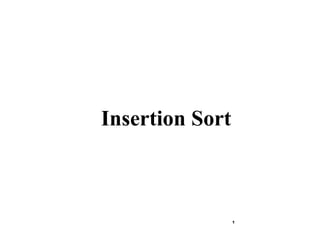
![2
Insertion Sort
• Suppose we know how to insert a new element x in its proper place
in an already sorted array A of size k, to get a new sorted array of
size k+1
• Use this to sort the given array A of size n as follows:
– Insert A[1] in the sorted array A[0]. So now A[0],A[1] are sorted
– Insert A[2] in the sorted array A[0],A[1]. So now
A[0],A[1],A[2] are sorted
– Insert A[3] in the sorted array A[0],A[1],A[2]. So now
A[0],A[1],A[2],A[3] are sorted
– …..
– Insert A[i] in the sorted array A[0],A[1],…,A[i-1]. So now
A[0],A[1],…A[i] are sorted
– Continue until i = n-1 (outer loop)](https://image.slidesharecdn.com/insertsortmergesort-240314062357-f92055b7/85/Insert-Sort-Merge-Sort-Using-C-Programming-2-320.jpg)
![3
How to do the first step
• Compare x with A[k-1] (the last element)
– If x ≥ A[k-1], we can make A[k] = x (as x is the max of
all the elements)
– If x < A[k-1], put A[k] = A[k-1] to create a hole in the k-
th position, put x there
• Now repeat by comparing x with A[k-2] (inserting x in its
proper place in the sorted subarray A[0],A[1],…A[k-1] of
k-2 elements)
• The value x bubbles to the left until it finds an element A[i]
such that x ≥ A[i]
• No need to compare any more as all elements A[0], A[1],
A[i] are less than x](https://image.slidesharecdn.com/insertsortmergesort-240314062357-f92055b7/85/Insert-Sort-Merge-Sort-Using-C-Programming-3-320.jpg)





![9
Insertion Sort Code
void InsertionSort (int A[ ], int size)
{
int i, j, item;
for (i=1; i<size; i++)
{ /* Insert the element in A[i] */
item = A[i] ;
for (j = i-1; j >= 0; j--)
if (item < A[j])
{ /* push elements down*/
A[j+1] = A[j];
A[j] = item ; /* can do this on
}
else break; /*inserted, exit loop */
}
}](https://image.slidesharecdn.com/insertsortmergesort-240314062357-f92055b7/85/Insert-Sort-Merge-Sort-Using-C-Programming-9-320.jpg)
![10
Look at the so
8
2
9
4
7
6
2
1
5
i = 1:: 2, 9, 4, 7
i = 2:: 9, 2, 4, 7
i = 3:: 9, 4, 2, 7
i = 4:: 9, 7, 4, 2
i = 5:: 9, 7, 6, 4
i = 6:: 9, 7, 6, 4
i = 7:: 9, 7, 6, 4
Result = 9, 7, 6, 5
void InsertionSort (int A[ ], int size) {
int i,j, item;
for (i=1; i<size; i++) {
printf("i = %d:: ",i);
for (j=0;j<size;j++) printf("%d, ",A[j]);
printf("n"); item = A[i] ;
for (j=i-1; j>=0; j--)
if (item > A[j])
{ A[j+1] = A[j]; A[j] = item ; }
else break;
}
int main() {
int X[100], i, size;
scanf("%d",&size);
for (i=0;i<size;i++) scanf("%d",&X[i]);
InsertionSort(X,size);
printf("Result = ");
for (i=0;i<size;i++) printf("%d, ",X[i]);
printf("n"); return 0;
}](https://image.slidesharecdn.com/insertsortmergesort-240314062357-f92055b7/85/Insert-Sort-Merge-Sort-Using-C-Programming-10-320.jpg)







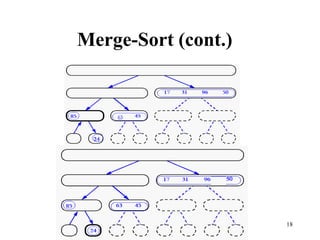
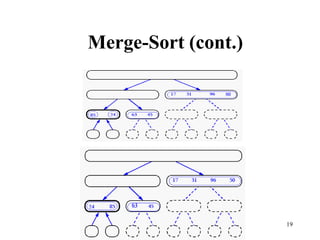
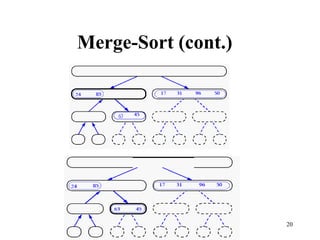
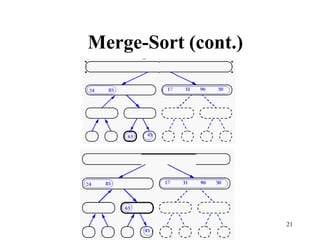







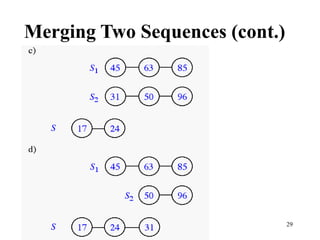
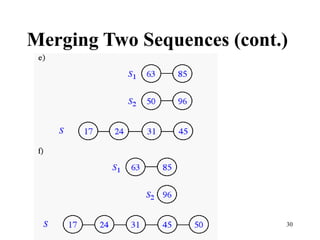


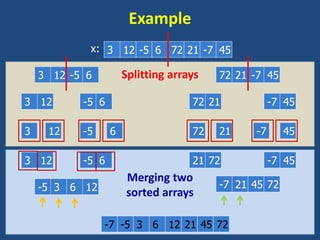

![Merge Sort C program
#include<stdio.h>
void mergesort(int a[],int i,int j);
void merge(int a[],int i1,int j1,int i2,int j2);
int main()
{
int a[30],n,i;
printf("Enter no of elements:");
scanf("%d",&n);
printf("Enter array elements:");
for(i=0;i<n;i++)
scanf("%d",&a[i]);
mergesort(a,0,n-1);
printf("nSorted array is :");
for(i=0;i<n;i++)
printf("%d ",a[i]);
return 0;
}
void mergesort(int a[],int i,int j)
{
int mid;
if(i<j) {
mid=(i+j)/2;
/* left recursion */
mergesort(a,i,mid);
/* right recursion */
mergesort(a,mid+1,j);
/* merging of two sorted sub-arrays */
merge(a,i,mid,mid+1,j);
}
}](https://image.slidesharecdn.com/insertsortmergesort-240314062357-f92055b7/85/Insert-Sort-Merge-Sort-Using-C-Programming-35-320.jpg)
![Merge Sort C program
void merge(int a[],int i1,int j1,int i2,int j2)
{
int temp[50]; //array used for merging
int i=i1,j=i2,k=0;
while(i<=j1 && j<=j2) //while elements in both lists
{
if(a[i]<a[j])
temp[k++]=a[i++];
else
temp[k++]=a[j++];
}
while(i<=j1) //copy remaining elements of the first list
temp[k++]=a[i++];
while(j<=j2) //copy remaining elements of the second list
temp[k++]=a[j++];
for(i=i1,j=0;i<=j2;i++,j++)
a[i]=temp[j]; //Transfer elements from temp[] back to a[]
}](https://image.slidesharecdn.com/insertsortmergesort-240314062357-f92055b7/85/Insert-Sort-Merge-Sort-Using-C-Programming-36-320.jpg)
